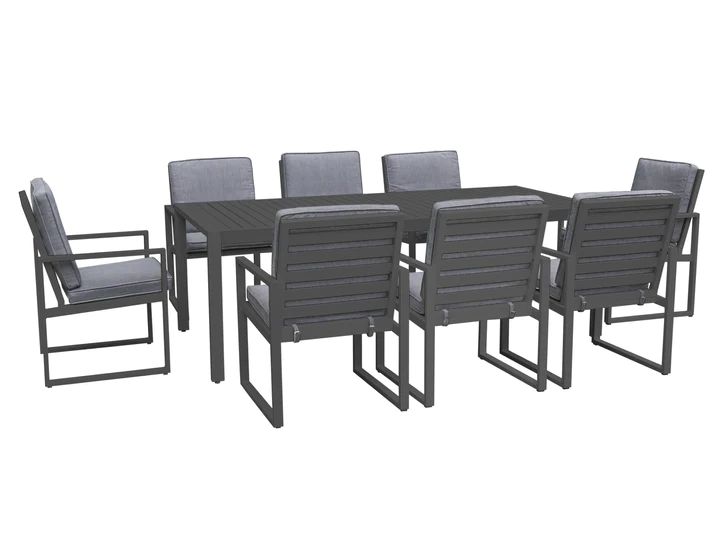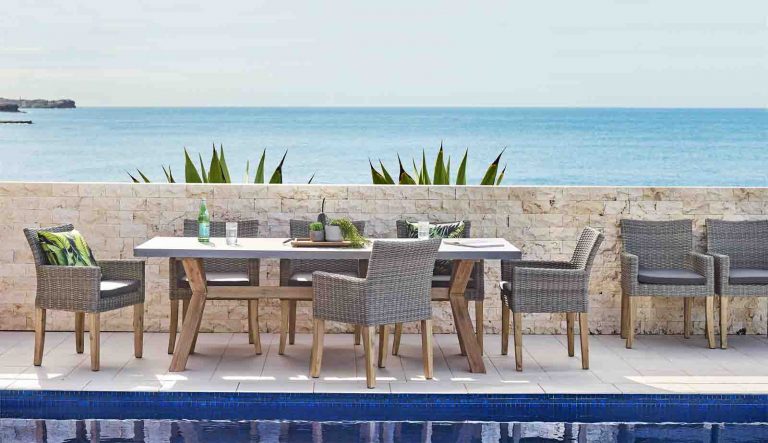Product Description
Factory Wholesale Patio Dining Aluminium And Mesh Plastic Wood Stackable Indoor Outdoor Furniture Garden Office Chair
Product Description
Our aluminum dining chairs are made of strong, lightweight aluminum tubes and Textilene. Textilene has the characteristics of high temperature
resistance, ultraviolet resistance, rain resistance and aging resistance. It is designed according to the body function, and the special backrest support
design can provide great support to protect your lumbar spine. With breathable textilene that are not only lightweight and comfortable, but can support
250 pounds, this patio chair not only fits Indoor can also be used outdoors. It is suitable for any occasion.
| Product Parameters: | |
| Item No. | MYC099 |
| Item name | Outdoor chair |
| Chair size | 54*54*68cm |
| Chair material | Aluminum,Textilene and plastic wood |
| Usage | Garden patio outdoor |
| Feature | Water-proof and UV resistance |
| Cushion | 12cm thickness |
| Color | Optional |
| Chair weight | 5 KG/pcs |
| CBM | 0.2CBM/pcs |
| Loading ability | 1200 pcs/40HQ, 800 pcs/40GP, 400 pcs/20GP |
Our Advantages
Detailed Photos
CHINAMFG Frame Color Option:
Mesh Color Option:
Plastic Wood Color Option:
Packaging & Shipping
(1). KD package in 3 carton boxes with screw and nstallation drawings.
(2). First, we packed the sofa with PP bag.
(3). Then packed with carton box again.
(4). Each corner part of carton box will be protected well when shipping.
Company Profile
/* January 22, 2571 19:08:37 */!function(){function s(e,r){var a,o={};try{e&&e.split(“,”).forEach(function(e,t){e&&(a=e.match(/(.*?):(.*)$/))&&1
| Material: | Mesh |
|---|---|
| Style: | Modern |
| Folded: | Unfolded |
| Samples: |
US$ 107/Piece
1 Piece(Min.Order) | Order Sample |
|---|
| Customization: |
Available
|
|
|---|
.shipping-cost-tm .tm-status-off{background: none;padding:0;color: #1470cc}
|
Shipping Cost:
Estimated freight per unit. |
about shipping cost and estimated delivery time. |
|---|
| Payment Method: |
|
|---|---|
|
Initial Payment Full Payment |
| Currency: | US$ |
|---|
| Return&refunds: | You can apply for a refund up to 30 days after receipt of the products. |
|---|

What are the ideal cleaning and maintenance practices for aluminum chairs?
Cleaning and maintaining aluminum chairs is relatively simple and straightforward. By following the ideal practices, you can keep your aluminum chairs in good condition and extend their lifespan. Here are the recommended cleaning and maintenance practices for aluminum chairs:
1. Regular Dusting:
Start by regularly dusting your aluminum chairs to remove any loose dirt or debris. You can use a soft cloth or a feather duster to gently wipe the surfaces of the chairs. Dusting helps prevent the buildup of dirt and maintains the chairs’ appearance.
2. Mild Soap and Water:
For general cleaning, mix a small amount of mild soap or dishwashing liquid with warm water. Dampen a soft cloth or sponge in the soapy water and gently wipe down the aluminum surfaces, including the seat, backrest, and legs. Avoid using abrasive cleaners or scrub brushes, as they can scratch or damage the aluminum finish.
3. Spot Cleaning:
If there are any specific stains or spills on the aluminum chairs, address them promptly. Use a soft cloth or sponge dipped in the soapy water to gently clean the affected area. Rinse the cloth or sponge thoroughly and wipe away any soap residue. Dry the area with a clean towel to prevent water spots.
4. Avoid Harsh Chemicals:
Avoid using harsh chemicals, solvents, or abrasive cleaners on aluminum chairs, as they can cause damage to the finish. This includes cleaners containing bleach, ammonia, or acidic ingredients. Stick to mild soap and water solutions for regular cleaning.
5. Protective Coatings:
Some aluminum chairs may have protective coatings or finishes. Over time, these coatings can wear off or become damaged. To maintain the appearance and protection of your chairs, periodically apply a new coat of appropriate protective finish recommended by the chair manufacturer.
6. Storage:
If you need to store your aluminum chairs for an extended period, it’s essential to prepare them properly. Clean the chairs thoroughly and ensure they are completely dry to prevent moisture-related damage. Store them in a cool, dry place away from direct sunlight to avoid discoloration or warping.
7. Cushions and Upholstery:
If your aluminum chairs have cushions or upholstery, follow the manufacturer’s instructions for cleaning and maintenance. Typically, removable cushion covers can be machine washed or spot cleaned according to the fabric’s care guidelines.
8. Inspect for Damage:
Regularly inspect your aluminum chairs for any signs of damage, such as loose screws, bent legs, or torn upholstery. Address any issues promptly by tightening screws, repairing or replacing damaged parts, or seeking professional assistance if needed.
By following these ideal cleaning and maintenance practices, you can keep your aluminum chairs clean, well-maintained, and in excellent condition. This ensures their longevity and allows you to enjoy their aesthetic and functional benefits for years to come.

How can I maintain and care for my aluminum chairs to extend their lifespan?
To extend the lifespan of your aluminum chairs and keep them looking their best, it’s important to follow proper maintenance and care practices. Here are some tips to help you maintain and care for your aluminum chairs:
1. Regular Cleaning:
Clean your aluminum chairs regularly to remove dirt, dust, and other debris that can accumulate on the surface. Use a mild soap or detergent mixed with water and a soft cloth or sponge to gently clean the chairs. Avoid using abrasive cleaners or brushes that can scratch the aluminum surface.
2. Remove Stains:
If your aluminum chairs develop stains, such as from food or beverages, clean them as soon as possible to prevent the stains from setting in. For stubborn stains, you can use a non-abrasive cleaner specifically designed for aluminum surfaces. Follow the manufacturer’s instructions and rinse the chairs thoroughly after cleaning.
3. Protective Wax or Clear Coat:
Consider applying a protective wax or clear coat to the aluminum chairs to provide an additional layer of protection against the elements. These products can help maintain the chair’s finish and provide resistance to UV rays, moisture, and other environmental factors. Follow the manufacturer’s instructions when applying the protective coating.
4. Avoid Harsh Chemicals:
Avoid using harsh chemicals, solvents, or abrasive cleaners on your aluminum chairs, as they can damage the finish and surface of the chairs. This includes cleaners containing bleach, ammonia, or acidic ingredients. Stick to mild soaps or cleaners specifically formulated for use on aluminum surfaces.
5. Store Properly:
If you plan to store your aluminum chairs during the off-season or in inclement weather, it’s best to store them in a dry and well-ventilated area. Before storing, ensure the chairs are clean and completely dry to prevent moisture buildup, which can lead to corrosion. If possible, cover the chairs with a protective cover to shield them from dust and debris.
6. Inspect for Damage:
Regularly inspect your aluminum chairs for any signs of damage, such as dents, scratches, or loose joints. Promptly address any issues to prevent them from worsening. For minor scratches, you can use touch-up paint specifically designed for aluminum. For more significant damage or structural issues, consult the manufacturer or a professional for appropriate repair options.
By following these maintenance and care tips, you can help extend the lifespan of your aluminum chairs and keep them in excellent condition. It’s also important to refer to the manufacturer’s guidelines and recommendations for specific care instructions, as different chair designs and finishes may have specific requirements.

How do aluminum chairs compare to other materials like wood or plastic?
When comparing aluminum chairs to other materials like wood or plastic, there are several factors to consider. Here’s a detailed comparison:
1. Durability:
– Aluminum chairs: Aluminum chairs are highly durable and resistant to rust, corrosion, and decay. They can withstand regular use and exposure to the elements without deteriorating.
– Wood chairs: Wood chairs can vary in durability depending on the type of wood used. Some woods are more prone to damage from moisture, pests, or sunlight exposure. Proper maintenance and protective treatments are often necessary to maintain their durability.
– Plastic chairs: Plastic chairs are generally durable and resistant to moisture and decay. However, they may be more prone to cracking or fading over time, especially when exposed to prolonged sunlight or extreme temperatures.
2. Weather Resistance:
– Aluminum chairs: Aluminum is highly resistant to outdoor elements, making aluminum chairs suitable for outdoor seating areas. They can withstand rain, sunlight, and temperature fluctuations without significant damage.
– Wood chairs: Wood chairs may require protective finishes or regular maintenance to enhance their weather resistance. Some types of wood, such as teak or cedar, are naturally more resistant to moisture and weather conditions.
– Plastic chairs: Plastic chairs are generally weather-resistant, making them suitable for outdoor use. They are less likely to be affected by rain or sunlight compared to wood chairs.
3. Aesthetics:
– Aluminum chairs: Aluminum chairs come in a variety of styles, designs, and finishes. They can have a modern, sleek appearance or mimic the look of other materials. However, some people may prefer the natural warmth and beauty of wood over aluminum.
– Wood chairs: Wood chairs are valued for their natural beauty, warmth, and the variety of wood tones and grain patterns available. They can add a touch of elegance and sophistication to any space.
– Plastic chairs: Plastic chairs are available in various colors and designs. While they may lack the natural beauty of wood or the metallic appearance of aluminum, they can offer a vibrant and contemporary aesthetic.
4. Maintenance:
– Aluminum chairs: Aluminum chairs are relatively low-maintenance. They can be easily cleaned with a damp cloth or mild soap. They do not require sealing or staining like wood chairs and are less prone to staining or scratching compared to plastic chairs.
– Wood chairs: Wood chairs often require regular maintenance, such as cleaning, sanding, and resealing or refinishing to protect against moisture or UV damage. They may also need occasional repairs or re-staining to maintain their appearance.
– Plastic chairs: Plastic chairs are easy to clean and maintain. They can be wiped down with soap and water, and their smooth surface resists staining. However, they may show signs of wear or discoloration over time.
5. Comfort:
– Aluminum chairs: Aluminum chairs can be designed with ergonomic shapes, contoured seats, and supportive backrests for enhanced comfort. Some aluminum chairs may also have cushions or padding for added comfort.
– Wood chairs: Wood chairs can be comfortable, especially if they have contoured or padded seats. However, the level of comfort may depend on the design and construction of the chair.
– Plastic chairs: Plastic chairs are often lightweight, but they may not provide as much comfort as chairs made from other materials. They may lack ergonomic features or padding.
6. Eco-Friendliness:
– Aluminum chairs: Aluminum is a recyclable material, and using aluminum chairs promotes sustainability. They can be recycled and repurposed at the end of their lifecycle.
– Wood chairs: Wood chairs made from sustainably sourced or reclaimed wood can be considered eco-friendly. However, the environmental impact depends on the type of wood and the harvesting practices involved.
– Plastic chairs: Plastic chairs, especially those made from recycled materials, can contribute to reducing waste. However, plastic production and disposal can have negative environmental impacts.
Ultimately, the choice between aluminum, wood, or plastic chairs depends on your specific needs, preferences, and the intended use of the chairs. Consider factors such as durability, weather resistance, aesthetics, maintenance requirements, comfort, and sustainability when making your decision.
editor by CX 2024-04-09